Middleton W.M. (ed.) Reference Data for Engineers: Radio, Electronics, Computer and Communications
Подождите немного. Документ загружается.

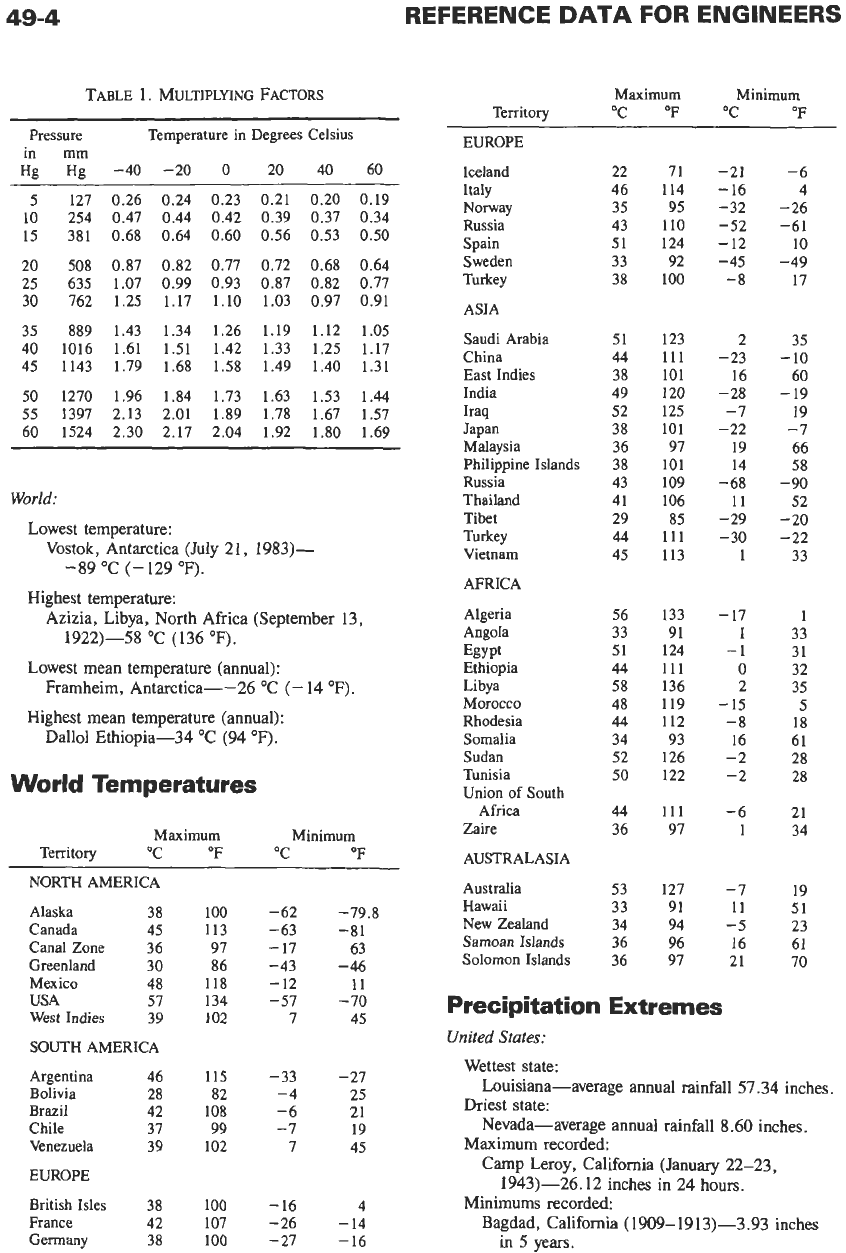
REFERENCE
DATA
FOR
ENGINEERS
TABLE
1.
MULTIPLYING
FACTORS
Pressure Temperature in Degrees Celsius
in mm
HE He
-40 -20 0 20 40 60
5
10
15
20
25
30
35
40
45
50
55
60
127 0.26
0.24
0.23 0.21
0.20 0.19
254 0.47
0.44 0.42
0.39 0.37
0.34
381 0.68
0.64
0.60 0.56
0.53 0.50
508 0.87
0.82 0.77 0.72
0.68 0.64
635 1.07
0.99 0.93
0.87 0.82 0.77
762 1.25 1.17
1.10 1.03
0.97 0.91
889 1.43
1.34 1.26 1.19 1.12 1.05
1016 1.61 1.51 1.42 1.33 1.25 1.17
1143
1.79 1.68 1.58 1.49
1.40 1.31
1270 1.96 1.84 1.73 1.63 1.53 1.44
1397 2.13 2.01 1.89 1.78
1.67 1.57
1524 2.30 2.17 2.04 1.92 1.80 1.69
World:
Lowest temperature:
Vostok,
Antarctica (July 21, 1983)-
-89 'C (-129 OF).
Highest temperature:
Azizia, Libya, North Africa (September 13,
1922)-58 "C
(136
OF).
Lowest mean temperature (annual):
Framheim, Antarctica--26 "C (-14
OF).
Highest mean temperature (annual):
Dallol Ethiopia-34
"C
(94
OF).
World Temperatures
Maximum
Territory "C
OF
~
NORTH AMERICA
Alaska
38
Canada
45
Canal Zone
36
Greenland
30
Mexico
48
USA
57
West Indies
39
SOUTH AMERICA
Argentina
46
Bolivia
28
Brazil
42
Chile
31
Venezuela
39
EUROPE
British Isles
38
France
42
Germany
38
100
113
97
86
118
134
102
115
82
108
99
102
100
107
100
Minimum
"C
OF
-62 -79.8
-63 -81
-17 63
-43 -46
-
12
11
-57 -70
7 45
-33 -27
-4
25
-6 21
-7 19
7 45
-
16 4
-26 -14
-27 -16
Territory
EUROPE
Iceland
Italy
Norway
Russia
Spain
Sweden
Turkey
ASIA
Saudi Arabia
China
East Indies
India
Iraq
Japan
Malaysia
Philippine Islands
Russia
Thailand
Tibet
Turkey
Vietnam
AFRICA
Algeria
Angola
Ethiopia
Libya
Morocco
Rhodesia
Somalia
Sudan
Tunisia
Union
of
Africa
Zaire
Egypt
S
outh
AUSTRALASIA
Australia
Hawaii
New Zealand
Samoan Islands
Solomon Islands
Maximum
"C OF
Minimum
"C
"F
22 71
46 114
35 95
43 110
51 124
33
92
38 100
51 123
44
111
38
101
49 120
52 125
38
101
36 97
38 101
43 109
41 106
29 85
44
111
45 113
56 133
33 91
51 124
44
111
58
136
48 119
44
112
34 93
52 126
50
122
44 111
36 97
53 127
33 91
34 94
36 96
36 97
-21 -6
-
16 4
-32 -26
-52 -61
-12 10
-45 -49
-8 17
2 35
-23 -10
16 60
-28 -19
-7 19
-22 -7
19 66
14 58
11 52
-68
-90
-29 -20
-30 -22
1
33
-
17
1
1
33
-1 31
0
32
2 35
-
15
5
-8 18
16 61
-2
28
-2 28
-6 21
1
34
-7 19
11
51
-5 23
16 61
21 70
Precipitation Extremes
United States:
Wettest state:
Driest state:
Maximum recorded:
Louisiana-average annual rainfall 57.34 inches.
Nevada-average annual rainfall 8.60 inches.
Camp Leroy, California (January 22-23,
1943)--26.12 inches in 24
hours.
Minimums recorded
in
5
years.
Bagdad, California (1909-1913)-3.93 inches
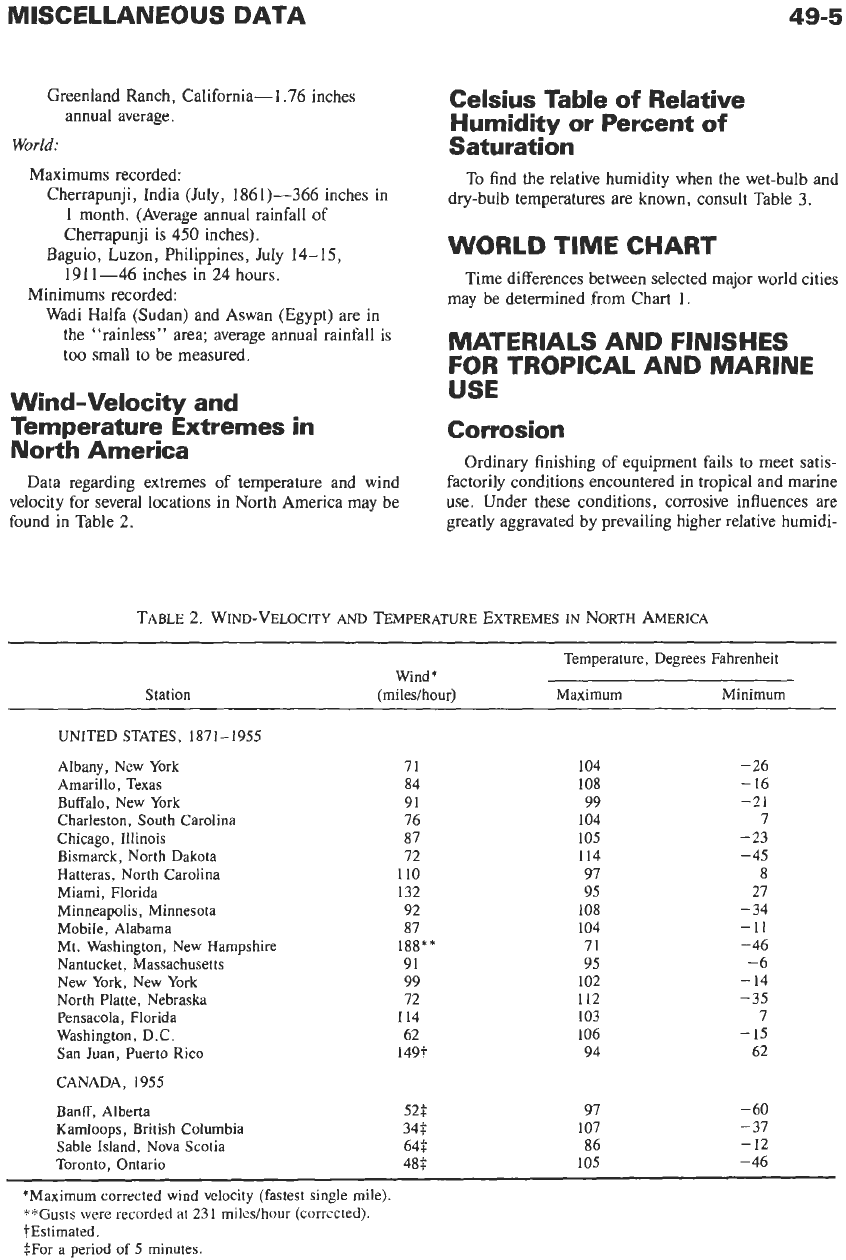
49-5
Greenland Ranch, California-I .76 inches
annual average.
World:
Maximums recorded:
Cherrapunji, India (July, 1861)-366 inches in
1
month. (Average annual rainfall of
Cherrapunji is
450
inches).
Baguio,
Luzon,
Philippines, July 14-15,
191
1-46 inches in 24 hours.
Minimums recorded:
Wadi Halfa (Sudan) and Aswan (Egypt) are in
the “rainless” area; average annual rainfall is
too small to be measured.
Wind-Velocity and
Temperature Extremes in
North America
Data regarding extremes of temperature and wind
velocity for several locations in North America may be
found in Table
2.
Celsius Table
of
Relative
Humidity or Percent
of
Saturation
To
find the relative humidity when the wet-bulb and
dry-bulb temperatures are
known,
consult Table 3.
WORLD
TIME
CHART
Time differences between selected major world cities
may be determined from Chart
1.
MATERIALS AND FINISHES
FOR TROPICAL AND MARINE
USE
Corrosion
Ordinary finishing
of
equipment fails
to
meet satis-
factorily conditions encountered in tropical and marine
use. Under these conditions, corrosive influences are
greatly aggravated by prevailing higher relative humidi-
TABLE
2.
WIND-VELOCITY
AND
TEMPERATURE EXTREMES
IN
NORTH AMERICA
Station
Temperature, Degrees Fahrenheit
Wind*
(miles/hour) Maximum
Minimum
UNITED STATES,
1871-195s
Albany,
New
York
Amarillo, Texas
Buffalo,
New
York
Charleston,
South
Carolina
Chicago, Illinois
Bismarck,
North
Dakota
Hatteras, North Carolina
Miami, Florida
Minneapolis, Minnesota
Mobile,
Alabama
Mt.
Washington,
New
Hampshire
Nantucket, Massachusetts
New
York,
New
York
North Platte, Nebraska
Pensacola, Florida
Washington, D
.C.
San Juan, Puerto Rico
CANADA,
1955
Banff, Alberta
Kamloops, British
Columbia
Sable
Island,
Nova
Scotia
Toronto, Ontario
71
84
91
76
87
72
110
132
92
87
188**
91
99
72
114
62
149i
104
108
99
104
105
114
97
95
108
104
71
95
102
112
103
106
94
97
107
86
105
-26
-
16
-21
7
-23
-45
8
27
-
34
-11
-
46
-6
-
14
-
35
7
-15
62
-60
-37
-
12
-
46
*Maximum
corrected
wind
velocity
(fastest single
mile).
**Gusts
were
recorded
at
231
miles/hour
(corrected).
?Estimated.
$For
a
period
of
5
minutes.
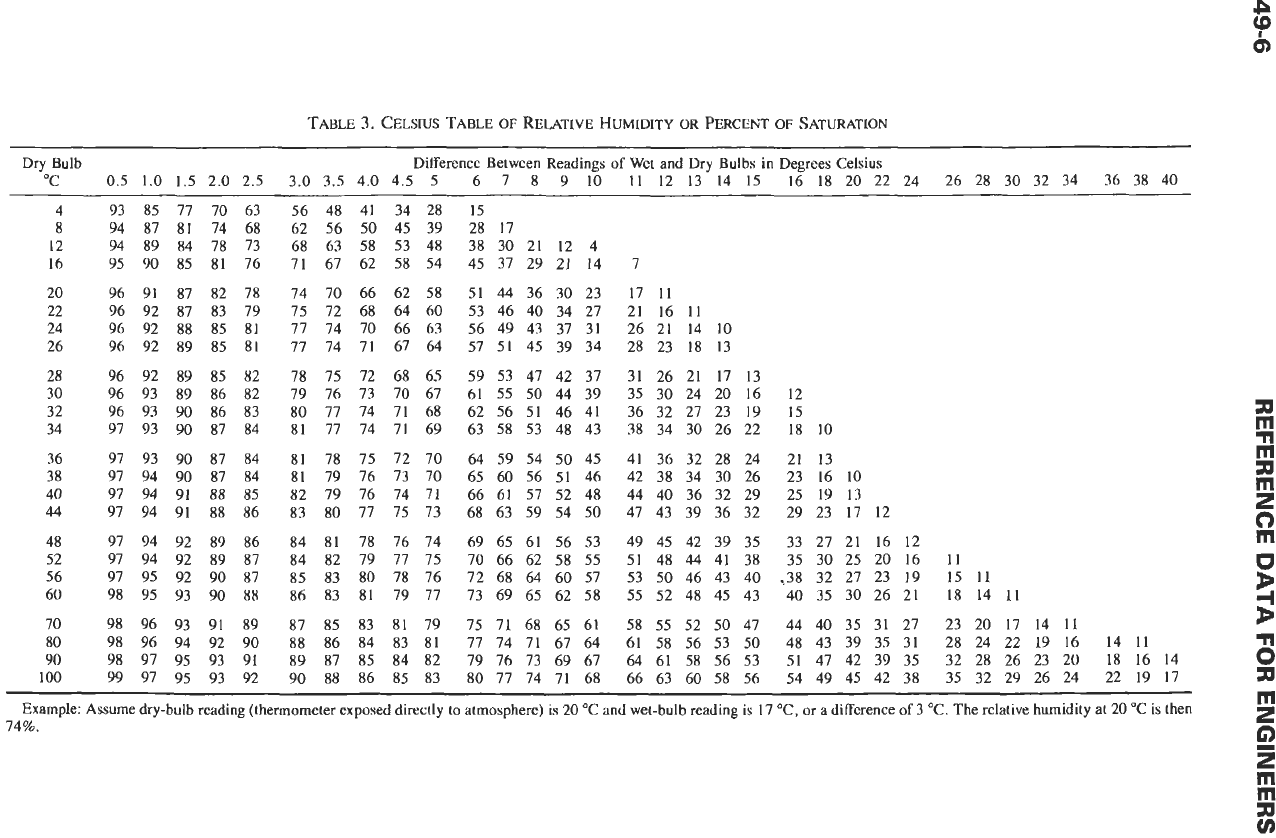
TABLE
3.
CELSIUS
TABLE
OF
RELATIVE
HUMIDITY
OR
PERCENT
OF
SATURATION
Dry Bulb
Difference Between Readings of Wet and Dry Bulbs in Degrees Celsius
"C 0.5 1.0 1.5 2.0 2.5 3.0 3.5 4.0 4.5 5 6 7 8 9 10 11 12 13 14 15 16 18 20 22 24 26 28 30 32 34 36 38 40
4 93
85 77 70
63
56 48
41 34 28 15
8 94
87
81 74
68 62 56
50 45
39 28 17
12 94
89
84 78
73 68 63
58
53
48 38 30 21 12 4
16 95
90 85 81
76 71 67
62 58
54 45 37 29 21 14 7
20 96
91
87
82 78 74 70 66 62
58
51 44
36 30 23
17 11
22 96
92
87 83
79 75
72
68
64
60
53 46
40
34 27
21 16 11
24 96
92
88 85
81 77
74 70 66
63
56 49
43 37 31 26 21 14 10
26 96
92 89 85
81 77
74 71 67
64 57
51 45 39 34 28 23 18 13
28 96
92 89 85
82
78 75
72 68 65
59
53
47 42
37 31
26 21
17 13
30 96
93
89 86
82
79 76 73 70
67 61 55
50
44 39
35
30 24
20 16 12
32 96
93
90 86
83
80
77 74 71
68 62
56
51
46 41
36 32 27
23 19 15
a
rn
34 97 93 90 87 84 81 77 74 71 69 63 58 53 48 43 38 34 30 26 22 18 10
n
rn
38 97 94 90 87 84 81 79 76 73 70 65 60 56 51 46 42 38 34 30 26 23 16 10
m
40 97 94 91 88 85 82 79 76 74 71 66
61
57 52 48 44 40 36 32 29 25 19 13
2
44
97 94 91 88 86 83 80 77 75 73 68 63 59 54 50 47 43 39 36 32 29 23 17 12
0
rn
52 97 94 92 89 87 84 82 79 77 75 70 66 62 58 55 51 48 44 41 38 35 30 25 20 16 11
0
56 97 95 92 90 87 85
83
80 78 76 72 68 64 60 57 53 50 46 43 40
.38
32 27 23 19 15 11
b
a
36 97 93 90 87 84 81 78 75 72 70 64 59 54
50
45 41 36 32 28 24 21 13
48 97 94 92 89 86 84 81 78 76 74 69 65 61 56 53 49 45 42 39 35 33 27 21 16 12
3
6
60 98 95 93 90 88 86 83 81 79 77 73 69 65 62 58 55 52 48 45 43 40 35 30 26 21 18 14 11
70 98
96 93 91
89 87 85
83 81
79 75 71
68
65
61
58 55
52
50
47 44
40
35 31 27 23
20
17
14 11
80 98
96
94 92
90 88 86
84 83
81 77 74
71 67 64 61 58
56 53
50 48 43 39
35
31 28
24
22
19 16 14 11
90 98
97 95
93
91
89 87 85 84
82
79 76
73
69 67
64
61 58
56 53 51
47 42
39
35
32
28 26
23 20 18 16 14
100 99
97 95
93
92 90 88 86
85
83 80 77 74 71 68
66 63
60
58 56 54
49
45
42
38 35 32
29
26 24 22 19 17
a
rn
2
74%.
G)
z
rn
m
Example: Assume dry-bulb reading (thermometer exposed directly to atmosphere) is 20 "C and wet-bulb reading is 17 "C,
or
a
difference
of
3 "C. The relative humidity at 20 "C is then
a
ua
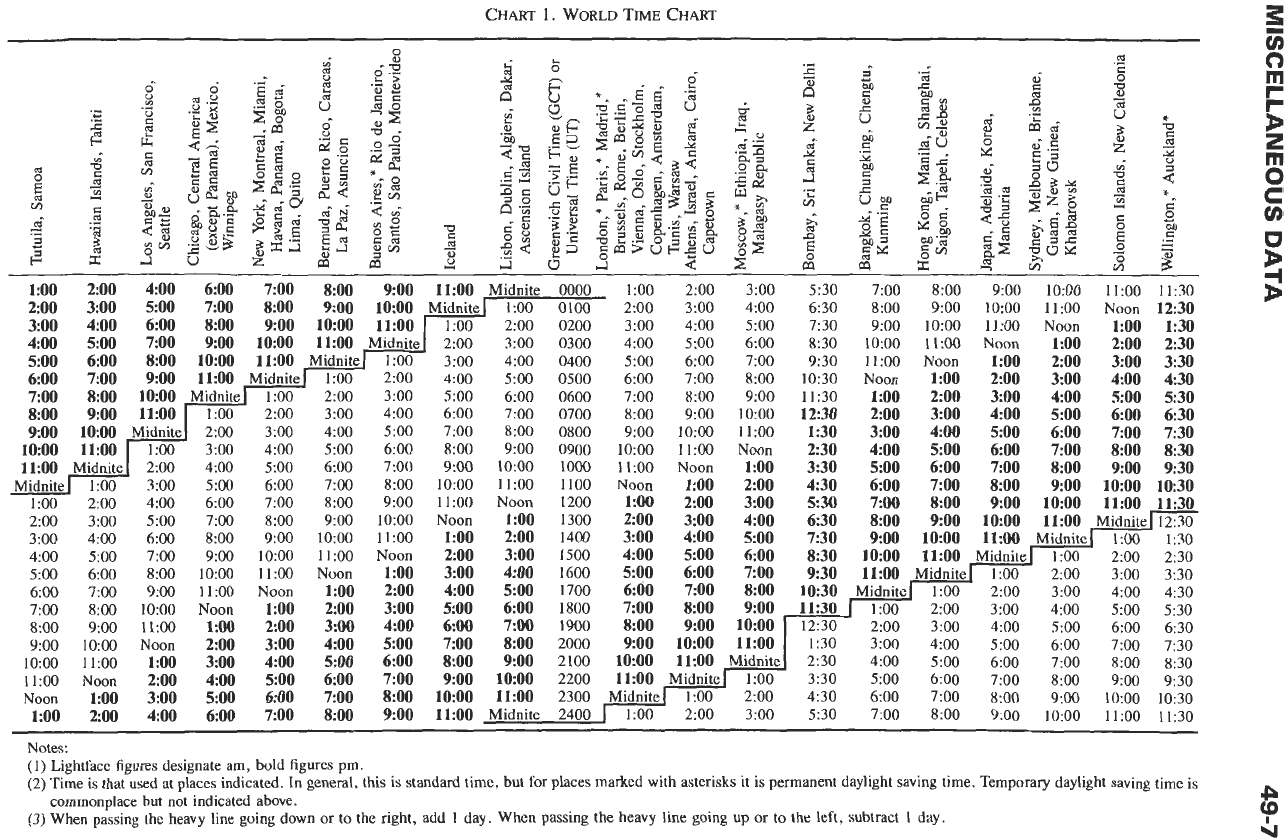
?
Q)
e
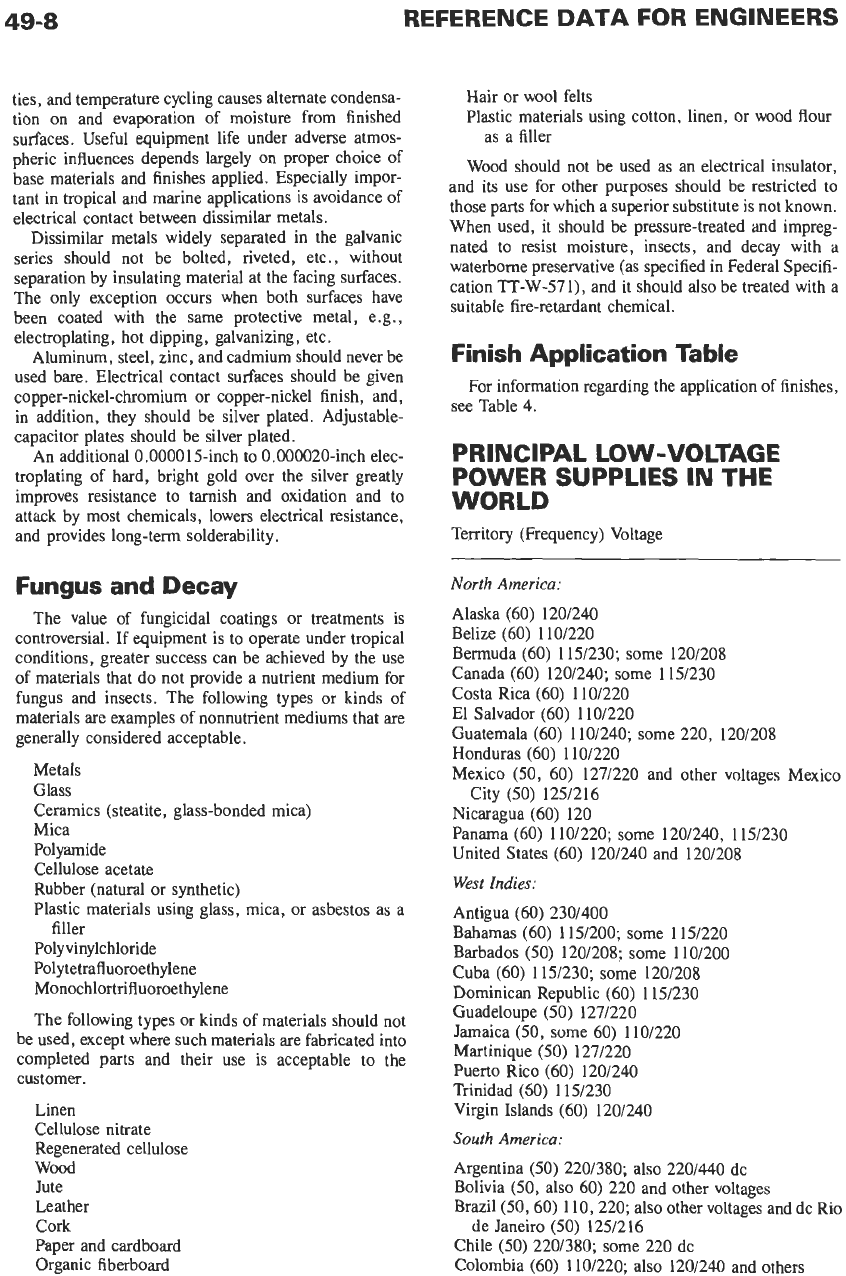
49-8
REFERENCE
DATA
FOR ENGINEERS
ties, and temperature cycling causes alternate condensa-
tion on and evaporation
of
moisture from finished
surfaces. Useful equipment life under adverse atmos-
pheric influences depends largely on proper choice of
base materials and finishes applied. Especially impor-
tant in tropical and marine applications is avoidance
of
electrical contact between dissimilar metals.
Dissimilar metals widely separated in the galvanic
series should not be bolted, riveted, etc., without
separation by insulating material at the facing surfaces.
The only exception occurs when both surfaces have
been coated with the same protective metal, e.g.,
electroplating, hot dipping, galvanizing, etc.
Aluminum, steel, zinc, and cadmium should never be
used bare. Electrical contact surfaces should be given
copper-nickel-chromium or copper-nickel finish, and,
in addition, they should be silver plated. Adjustable-
capacitor plates should be silver plated.
An additional 0.000015-inch to 0.000020-inch elec-
troplating of hard, bright gold over the silver greatly
improves resistance to tarnish and oxidation and to
attack by most chemicals, lowers electrical resistance,
and provides long-term solderability,
Hair or wool felts
Plastic materials using cotton, linen, or wood flour
Wood should not be used as an electrical insulator,
and its use for other purposes should be restricted to
those parts
for
which a superior substitute is not known.
When used, it should be pressure-treated and impreg-
nated to resist moisture, insects, and decay with a
waterborne preservative (as specified in Federal Specifi-
cation TT-W-571), and it should also be treated with a
suitable fire-retardant chemical.
as a filler
Finish Application
Table
For information regarding the application
of
finishes,
see Table 4.
PRINCIPAL LOW-VOLTAGE
POWER SUPPLIES
IN
THE
WORLD
Territory (Frequency) Voltage
Fungus and Decay
The value
of
fungicidal coatings or treatments is
controversial. If equipment is to operate under tropical
conditions, greater success can be achieved by the use
of
materials that do not provide a nutrient medium for
fungus and insects. The following types or kinds
of
materials are examples of nonnutrient mediums that are
generally considered acceptable.
Metals
Glass
Ceramics (steatite, glass-bonded mica)
Mica
Polyamide
Cellulose acetate
Rubber (natural
or
synthetic)
Plastic materials using glass, mica, or asbestos as a
Poly vinylchloride
Polytetrafluoroethylene
Monochlortrifluoroethylene
The following types or kinds
of
materials should not
be used, except where such materials are fabricated into
completed parts and their use is acceptable to the
customer.
Linen
Cellulose nitrate
Regenerated cellulose
Wood
Jute
Leather
Cork
Paper and cardboard
Organic fiberboard
filler
North America:
Alaska (60) 120/240
Belize
(60)
110/220
Bermuda
(60)
115/230;
some
120/208
Canada (60) 120/240; some 115/230
Costa Rica
(60)
110/220
El Salvador
(60)
110/220
Guatemala
(60)
1101240; some 220, 120/208
Honduras
(60)
110/220
Mexico
(50,
60)
127/220 and other voltages Mexico
Citv
(50)
1251216
Nicarigua (60) 120
Panama
(60)
110/220; some 120/240, 113230
United States (60) 120/240 and 120/208
West Indies:
Antigua
(60)
230/400
Bahamas
(60)
115/200; some 113220
Barbados
(50)
120/208; some 1101200
Cuba (60) 115/230; some 120/208
Dominican Republic
(60)
115/230
Guadeloupe
(50)
127/220
Jamaica
(50,
some
60)
110/220
Martinique
(50)
127/220
Puerto Rico (60) 120/240
Trinidad
(50)
1 15/230
Virgin Islands
(60)
120/240
South
America:
Argentina
(50)
220/380; also 220/440 dc
Bolivia
(50,
also
60) 220 and other voltages
Brazil
(50,60)
110,220; also other voltages and dc Rio
Chile
(50)
2201380; some 220 dc
Colombia
(60)
110/220; also 120/240 and others
de Janeiro
(50)
125/216

49-9
TABLE
4.
FIh’ISH
APPLICATION TABLE*
Material Finish Remarks
Aluminum alloy Anodizing An electrochemical-oxidation surface treatment, for improving
corrosion resistance; not an electroplating process. For riveted
or welded assemblies, specify chromic acid anodizing. Do not
anodize parts with nonaluminum inserts. Colors vary: yellow-
green, gray, or black.
“Alrok”
Chemical-dip oxide treatment. Cheap. Inferior in abrasion and
corrosion resistance to the anodizing process, but applicable to
assemblies of aluminum and nonaluminum materials.
Copper and zinc alloys
Brass, bronze, zinc die-
Bright acid dip
Brass, chrome, nickel, tin
Immersion of parts in acid solution. Clear lacquer applied to
As discussed under steel.
prevent tarnish.
casting alloys
Magnesium alloy
Dichromate treatment Corrosion-preventive dichromate dip. Yellow color.
Stainless steel
Passivating treatment Nitric-acid immunizing dip.
Steel Cadmium Electroplate, dull white color, good corrosion resistance, easily
scratched, good thread antiseize. Poor wear and galling resist-
ance.
Chromium
Electroplate, excellent corrosion resistance and lustrous appear-
ance. Relatively expensive. Specify hard chrome plate for
exceptionally hard abrasion-resistive surface. Has low coeffi-
cient of friction. Used to some extent
on
nonferrous metals
particularly when die-cast. Chrome-plated objects usually
receive a base electroplate of copper, then nickel, followed by
chromium. Used for buildup of parts that are undersized. Do
not
use
on parts with deep recesses.
Blueing
Immersion of cleaned and polished steel into heated saltpeter or
carbonaceous material. Part then rubbed with linseed oil.
Cheap. Poor corrosion resistance.
Silver plate
Electroplate, frosted appearance; buff to brighten. Tarnishes
readily. Good bearing lining. For electrical contacts, reflec-
tors.
Zinc plate
Dip in molten zinc (galvanizing) or electroplate of low-carbon or
low-alloy steels. Low cost. Generally inferior
to
cadmium
plate. Poor appearance. Poor wear resistance: Electroplate has
better adherence to base metal than hot-dip coating. For
improving corrosion resistance, zinc-plated parts are given
special inhibiting treatments.
~~
Nickel plate
Electroplate, dull white. Does not protect steel from galvanic
corrosion. If plating is broken, corrosion of base metal will be
hastened. Finishes in dull white, polished,
or
black.
Do
not
use
on parts with deep recesses.
Nonmetallic chemical black oxidizing treatment for steel, cast
iron, and wrought iron. Inferior to electroplate. No buildup.
Suitable for parts with close dimensional requirements as
gears, worms, and guides. Poor abrasion resistance.
Black-oxide dip
~ ~~
Phosphate treatment
Nonmetallic chemical treatment for steel and iron products.
Suitable for protection of internal surfaces of hollow parts.
Small amount of surface buildup. Inferior to metallic electro-
plate. Poor abrasion resistance. Good paint
base.
Continued on next page.
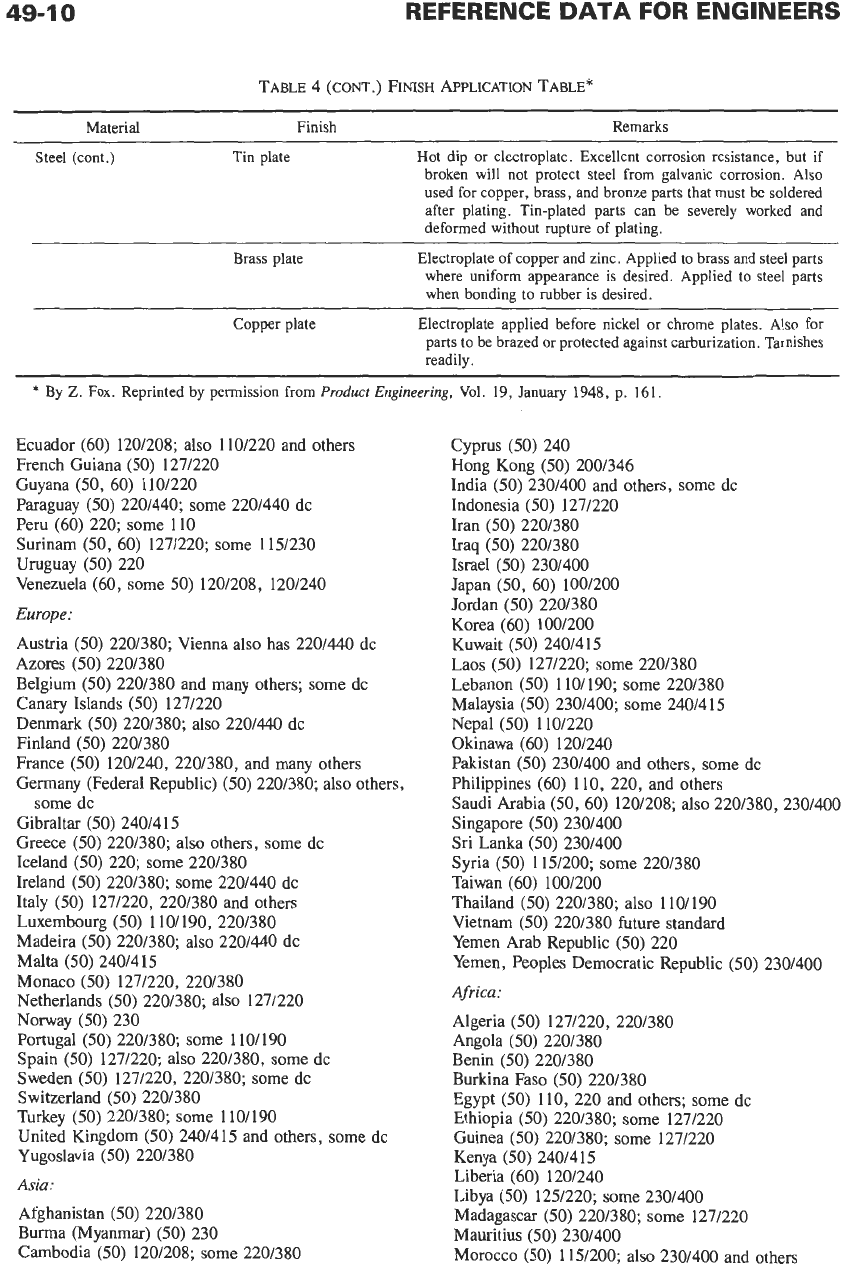
49-1
0
REFERENCE
DATA
FOR
ENGINEERS
TABLE 4 (CONT.) FINISH
APPLICATION
TABLE*
Material Finish Remarks
Steel (cont.) Tin plate
Hot dip
or
electroplate. Excellent corrosion resistance, but if
broken will not protect steel from galvanic corrosion. Also
used for copper, brass, and bronze parts that must be soldered
after plating. Tin-plated parts can be severely worked and
deformed without rupture
of
plating.
Brass plate
Electroplate of copper and zinc. Applied to brass and steel parts
where uniform appearance is desired. Applied to
steel
parts
when bonding to rubber is desired.
Copper plate Electroplate applied before nickel or chrome plates.
Also
for
parts to be brazed
or
protected against carburization. Tarnishes
readily.
*
By
Z.
Fox. Reprinted by permission from
Product
Engineering,
Vol.
19,
January
1948,
p.
161.
Ecuador
(60)
1201208;
also
110/220 and others
French Guiana
(50)
1271220
Guyana
(50,
60) 110/220
Paraguay
(50)
220/440; some 220/440 dc
Peru (60) 220; some 110
Surinam
(50,
60) 127/220; some 115/230
Uruguay (50) 220
Venezuela (60, some 50) 120/208, 120/240
Europe:
Austria
(50)
220/380; Vienna also has 220/440 dc
Azores
(50)
220/380
Belgium (50) 220/380 and many others; some dc
Canary Islands (50) 127/220
Denmark
(50)
220/380; also 220/440 dc
Finland
(50)
220/380
France (50) 120/240, 220/380, and many others
Germany (Federal Republic)
(50)
220/380; also others,
Gibraltar
(50)
240/415
Greece (50) 2201380;
also
others, some dc
Iceland (50) 220; some 220/380
Ireland
(50)
2201380; some 220/440 dc
Italy (50) 127/220, 220/380 and others
Luxembourg (50) 110/190, 220/380
Madeira (50) 220/380; also 220/440 dc
Malta (50) 240/415
Monaco
(50)
1271220, 220/380
Netherlands (50) 2201380; also 127/220
Norway (50) 230
Portugal (50) 220/380; some 110/190
Spain
(50)
127/220; also 220/380, some dc
Sweden (50) 127/220, 220/380; some dc
Switzerland (50) 220/380
Turkey
(SO)
220/380; some 110/190
United Kingdom (50) 240/415 and others, some dc
Yugoslavia (50) 220/380
Asia:
Afghanistan (50) 220/380
Burma (Myanmar)
(50)
230
Cambodia
(50)
120/208; some 220/380
some dc
Cyprus (50) 240
Hong Kong
(50)
200/346
India
(50)
2301400 and others, some dc
Indonesia (50) 127/220
Iran (50) 220/380
Iraq
(50)
220/380
Israel
(50)
230/400
Japan (50,
60)
100/200
Jordan
(50)
220/380
Korea (60) 100/200
Kuwait
(50)
240/415
Laos (50) 127/220; some 220/380
Lebanon
(50)
110/190; some 220/380
Malaysia
(50)
230/400; some 240/415
Nepal (50) 1101220
Okinawa (60) 120/240
Pakistan
(50)
2301400 and others, some dc
Philippines (60)
110,
220, and others
Saudi Arabia (50, 60) 120/208; also 220/380, 230/400
Singapore (50) 2301400
Sri Lanka (50) 230/400
Syria
(50)
115/200; some 220/380
Taiwan (60) 1001200
Thailand
(50)
220/380; also 110/190
Vietnam
(50)
2201380 future standard
Yemen Arab Republic
(50)
220
Yemen, Peoples Democratic Republic
(50)
230/400
Africa:
Algeria
(50)
127/220, 220/380
Angola (50) 220/380
Benin
(50)
220/380
Burkina Faso
(50)
220/380
Egypt
(50)
110, 220 and others; some dc
Ethiopia (50) 2201380; some 127/220
Guinea (50) 220/380; some 127/220
Kenya
(50)
240/415
Liberia (60) 120/240
Libya
(50)
125/220; some 230/400
Madagascar (50) 220/380; some 127/220
Mauritius (50) 230/400
Morocco (50) 115/200;
also
230/400 and others
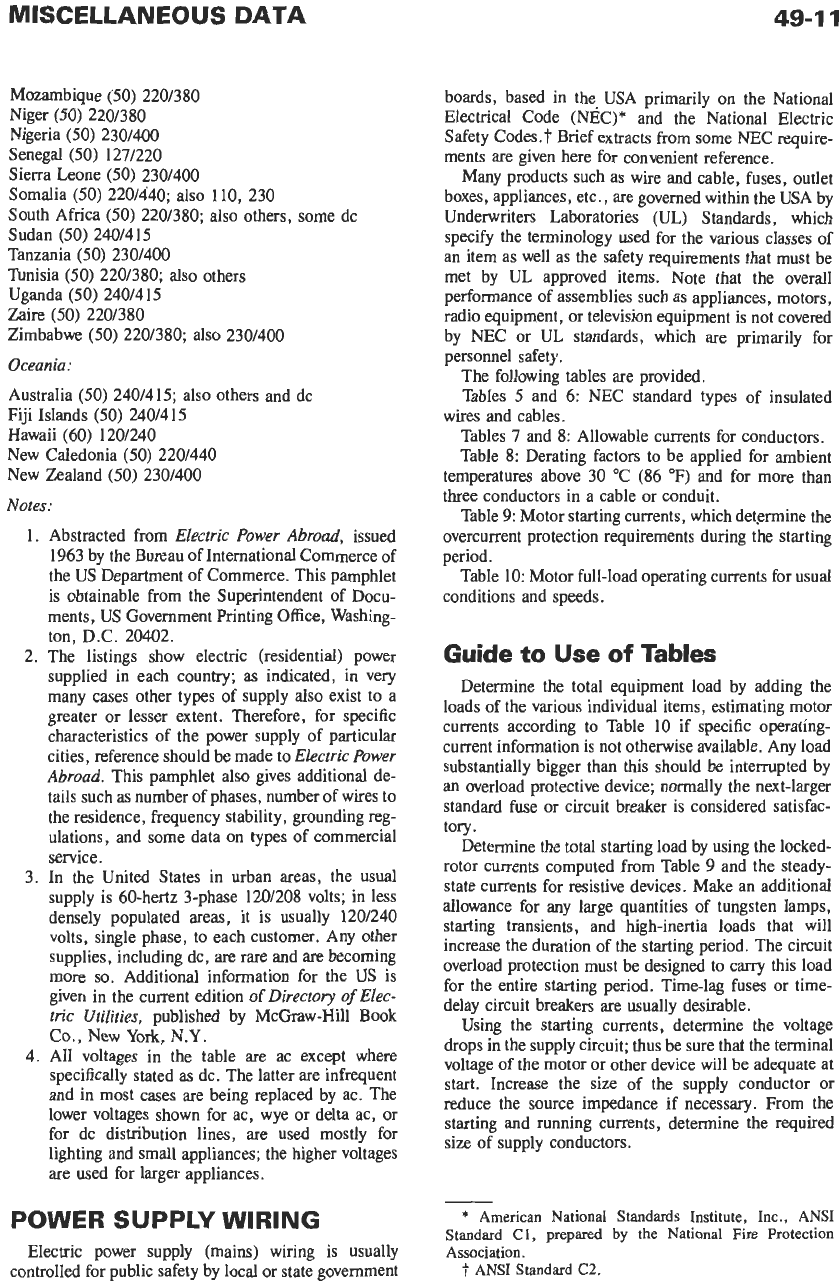
49-1
1
Mozambique
(50)
220/380
Niger
(50)
220/380
Nigeria
(50)
230/400
Senegal
(50)
127/220
Sierra Leone
(50)
230/400
Somalia
(50)
220/440;
also
110,
230
South Africa
(50)
2201380;
also
others, some dc
Sudan
(50)
240/415
Tanzania
(50)
230/400
Tunisia
(50)
2201380;
also others
Uganda
(50)
240/415
Zaire
(50)
220/380
Zimbabwe
(50)
220/380;
also
230/400
Oceania:
Australia
(50)
240/415;
also
others and dc
Fiji Islands
(50)
240/415
Hawaii
(60) 120/240
New Caledonia
(50)
220/440
New Zealand
(50)
230/400
Notes:
boards, based in the. USA primarily
on
the National
Electrical Code (NEC)* and the National Electric
Safety Codes.? Brief extracts from some NEC require-
ments are given here for convenient reference.
Many products such as wire and cable, fuses, outlet
boxes, appliances, etc., are governed within the USA by
Underwriters Laboratories (UL) Standards, which
specify the terminology used for the various classes
of
an item as well as the safety requirements that must be
met by UL approved items. Note that the overall
performance of assemblies such as appliances, motors,
radio equipment, or television equipment is not covered
by NEC or UL standards, which are primarily for
personnel safety.
The following tables
are
provided.
Tables
5
and
6:
NEC standard types of insulated
Tables
7
and
8:
Allowable currents for conductors.
Table
8:
Derating factors to be applied for ambient
temperatures above
30
"C
(86
OF) and for more than
three conductors in a cable or conduit.
Table
9:
Motor starting currents, which det.ermine the
wires and cables.
-
Abstracted from
Electric Power Abroad,
issued
1963
by the Bureau of International Commerce of
the US Department of Commerce. This pamphlet
is obtainable from the Superintendent of Docu-
ments,
US
Government Printing Office, Washing-
overcurrent protection requirements during the starting
period.
Table
10:
Motor full-load operating currents for
usual
conditions and speeds.
ton, D.c.
20402.
The listings show electric (residential) power
I
.,
Guide
to
Use
Of
Tables
Determine the total equipment load by adding the
supplied in each country; as indicated, in very
many
Other
types
Of
exist
to
a
loads of the various individual items, estimating motor
currents according to Table
10
if specific operating-
greater or lesser extent. Therefore, for specific
characteristics
Of
the
power
Of
current information is not otherwise available. Any load
cities, reference should be made to
Electric Power
bigger
than
this
should
be intempted
by
standard fuse or circuit breaker is considered satisfac-
tails such as number of phases, number
of
wires to
the residence, frequency stability, grounding reg-
+n...r
This
pamphlet gives
de-
an
overload protective device; the n&-larger
ulations, and some data
on
types of commercial
service.
,
In
the United States in urban areas, the usual
supply
is
60-hertz 3-phase
120/208
volts; in less
densely populated areas, it is usually
1201240
volts, single phase, to each customer. Any other
supplies, including dc, are rare and
are.
becoming
more
so.
Additional information for the
US
is
given in the current edition of
Directory
of
Elec-
tric Utilities,
published by McGraw-Hill
Book
Co.,
New York,
N.Y.
4.
All voltages in the table are ac except where
specifically stated as dc. The latter are infrequent
and in most cases are being replaced by ac. The
lower voltages shown for ac, wye or delta ac, or
for dc distribution lines, are used mostly for
lighting and small appliances; the higher voltages
are used for larger appliances.
ru1y.
Determine the total starting load by using the locked-
rotor currents computed from Table
9
and the steady-
state currents for resistive devices. Make an additional
allowance for
any
large quantities of tungsten lamps,
starting transients, and high-inertia loads that will
increase the duration of the starting period. The circuit
overload protection must be designed to
carry
this load
for the entire starting period. Time-lag fuses or time-
delay circuit breakers are usually desirable.
Using the starting currents, determine the voltage
drops in the supply circuit; thus be sure that the terminal
voltage
of
the motor or other device will be adequate at
start.
Increase the size
of
the supply conductor or
reduce the source impedance if necessary. From the
starting and running currents, determine the required
size of supply conductors.
*
American National Standards Institute, Inc.,
ANSI
Standard
C1,
prepared
by
the National Fire Protection
Association.
POWER SUPPLY WIRING
Electric power supply (mains) wiring is usually
controlled for public safety by local or state government
f
ANSI
Standard
C2.
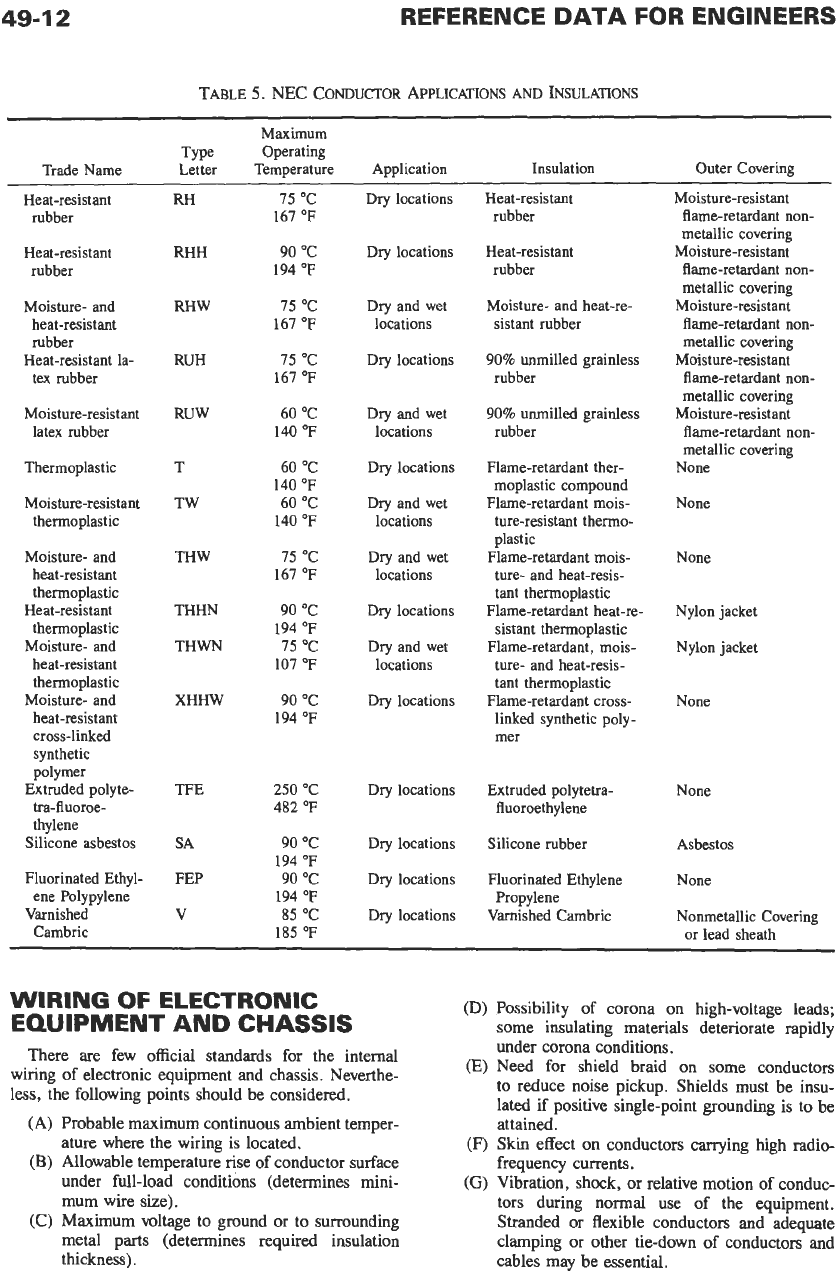
49-1
2
TABLE
5.
NEC
CONDUCTOR
APPLICATIONS
AND
INSULATIONS
~
Maximum
Operating
Temperature
75
"C
167 OF
90
"C
194 "F
75
"C
167 "F
15
"C
167 "F
60
"C
140
OF
60
"C
140
OF
60
"C
140 "F
Type
Letter
RH
Application
Insulation Outer Covering
Trade Name
Heat-resistant
rubber
Heat-resistant
rubber
Moisture-resistant
flame-retardant non-
metallic covering
Moisture-resistant
flame-retardant
non-
metallic covering
Moisture-resistant
flame-retardant non-
metallic covering
Moisture-resistant
flame-retardant non-
metallic covering
Moisture-resistant
flame-retardant non-
metallic covering
None
None
Dry locations
Heat-resistant
rubber
RHH
Dry locations
Heat-resistant
rubber
Moisture- and
heat-resistant
rubber
Heat-resistant la-
tex rubber
RHW
Dry and wet
locations
Moisture- and heat-re-
sistant rubber
RUH
Dry locations
90% unmilled grainless
rubber
Moisture-resistant
latex rubber
RUW Dry and wet
locations
90% unmilled grainless
rubber
Thermoplastic
Moisture-resistant
thermoplastic
Moisture- and
heat-resistant
thermoplastic
Heat-resistant
thermoplastic
Moisture- and
heat-resistant
thermoplastic
Moisture- and
heat-resistant
cross-linked
synthetic
polymer
tra-fluoroe-
thylene
Extruded polyte-
Silicone asbestos
T
TW
Dry locations
Dry and wet
locations
Flame-retardant ther-
moplastic compound
Flame-retardant mois-
ture-resistant thermo-
plastic
Flame-retardant mois-
ture- and heat-resis-
tant thermoplastic
Flame-retardant heat-re-
sistant thermoplastic
Flame-retardant, mois-
ture- and heat-resis-
tant thermoplastic
Flame-retardant cross-
linked synthetic poly-
mer
THW 75
"C
167 OF
Dry and wet
locations
Dry locations
Dry and wet
locations
Dry locations
None
THHN
THWN
90
'C
194 OF
75
OC
107 OF
90
"C
194 "F
Nylon jacket
Nylon jacket
XHHW
None
TFE 250
'C
482 OF
90
"C
194 OF
90
"C
194 "F
85
"C
185 "F
Dry locations
Extruded polytetra-
fluoroethylene
Silicone rubber
Fluorinated Ethylene
Varnished Cambric
Propylene
None
SA
FEP
V
Dry locations
Dry locations
Dry locations
Asbestos
None
Nonmetallic Covering
or
lead sheath
Fluorinated Ethyl-
ene Polypylene
Varnished
Cambric
WIRING
OF
ELECTRONIC
EQUIPMENT AND CHASSIS
(D)
Possibility of corona on high-voltage leads;
some insulating materials deteriorate rapidly
~.
under corona conditions.
(E)
Need for shield braid on some conductors
to
reduce noise pickup. Shields must be insu-
lated if positive single-point grounding is to be
attained.
(F)
Skin effect on conductors carrying high radio-
frequency currents.
(G)
Vibration, shock, or relative motion of conduc-
tors during normal use of the equipment.
Stranded or flexible conductors and adequate
clamping or other tie-down of conductors and
cables may be essential.
There
are
few official standards for the internal
wiring of electronic equipment and chassis. Neverthe-
less, the following points should be considered.
(A)
Probable maximum continuous ambient temper-
ature
where the wiring
is
located.
(B)
Allowable temperature rise of conductor surface
under full-load conditions (determines mini-
mum wire size).
(C)
Maximum voltage
to
ground or
to
surrounding
metal parts (determines required insulation
thickness).
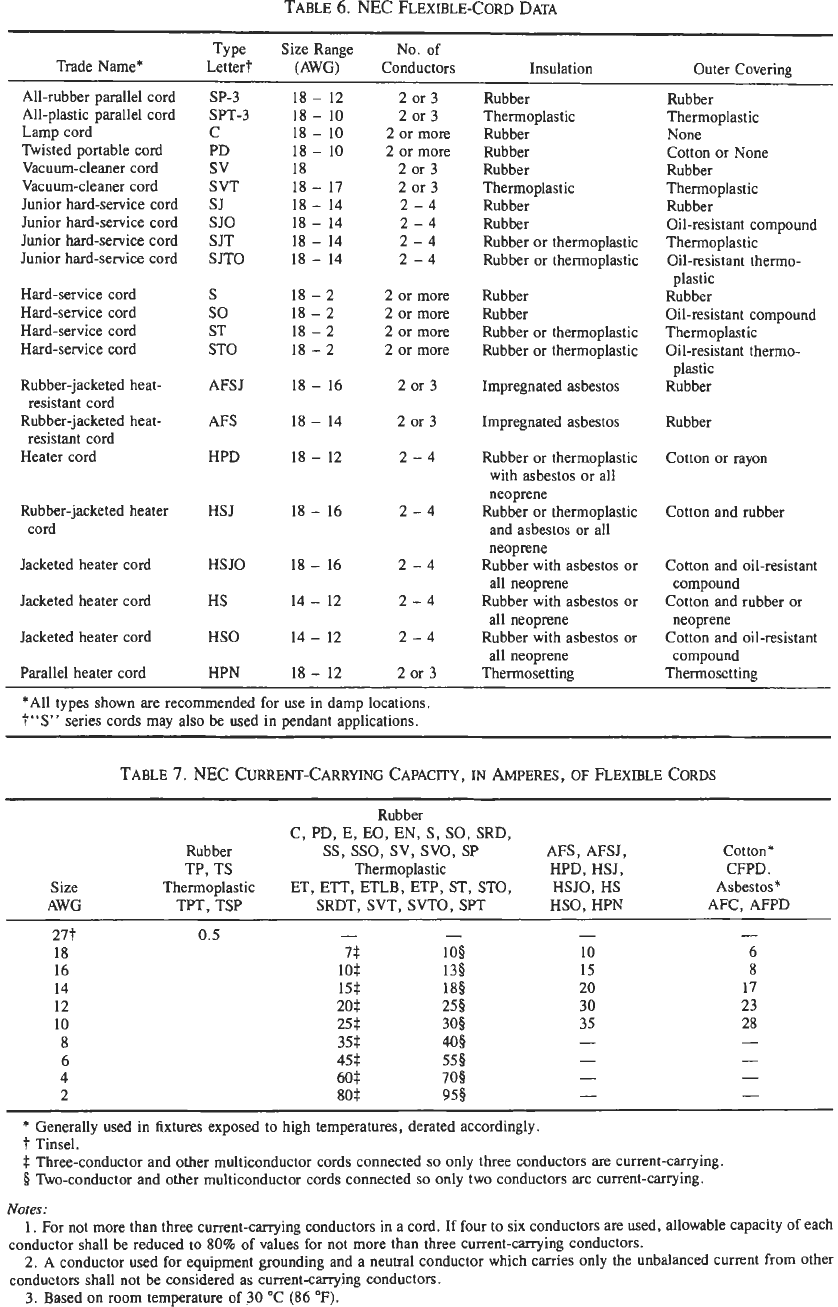
TABLE
6.
NEC
FLEXIBLE-CORD
DATA
~
Type Size Range
No.
of
Outer Covering Insulation
Trade Name* Letter? (AWG) Conductors
All-rubber parallel cord
All-plastic parallel cord
Lamp cord
Twisted portable cord
Vacuum-cleaner cord
Vacuum-cleaner cord
Junior hard-service cord
Junior hard-service cord
Junior hard-service cord
Junior hard-service cord
Hard-service cord
Hard-service cord
Hard-service cord
Hard-service cord
Rubber-jacketed heat-
Rubber-jacketed heat-
Heater cord
resistant cord
resistant cord
Rubber-jacketed heater
cord
Jacketed heater cord
Jacketed heater cord
Jacketed heater cord
Parallel heater cord
SP-3
SPT-3
C
PD
sv
SVT
SJ
SJO
SJT
SJTO
S
so
ST
STO
AFS J
AFS
HPD
HSJ
HSJO
HS
HSO
HPN
18
-
12
18
-
10
18
-
10
18
-
10
18
18
-
17
18
-
14
18
-
14
18
-
14
18
-
14
18-2
18
-
2
18
-
2
18-2
18
-
16
18
-
14
18
-
12
18
-
16
18
-
16
14
-
12
14
-
12
18
-
12
2
or 3
2
or
3
2
or more
2
or more
2
or 3
2
or 3
2-4
2-4
2-4
2-4
2
or more
2
or
more
2
or more
2
or
more
2
or
3
2
or
3
2-4
2-4
2-4
2-4
2-4
2
or
3
Rubber
Thermoplastic
Rubber
Rubber
Rubber
Thermoplastic
Rubber
Rubber
Rubber or thermoplastic
Rubber or thermoplastic
Rubber
Rubber
Rubber or thermoplastic
Rubber
or
thermoplastic
Impregnated asbestos
Impregnated asbestos
Rubber or thermoplastic
with asbestos or all
neoprene
and asbestos or all
neoprene
Rubber with asbestos or
all neoprene
Rubber with asbestos or
all neoprene
Rubber with asbestos or
all neoprene
Thermosetting
Rubber or thermoplastic
Rubber
Thermoplastic
None
Cotton or None
Rubber
Thermoplastic
Rubber
Oil-resistant compound
Thermoplastic
Oil-resistant thermo-
plastic
Rubber
Oil-resistant compound
Thermoplastic
Oil-resistant thermo-
plastic
Rubber
Rubber
Cotton or rayon
Cotton and rubber
Cotton and oil-resistant
compound
Cotton and rubber or
neoprene
Cotton and oil-resistant
compound
Thermosetting
*All types shown are recommended for use in damp locations.
t"S"
series cords may also be used in pendant applications.
~~~~~~ ~~~
TABLE
7.
NEC
CURRENT-CARRYING CAPACmY,
IN
AMPERES,
OF
FLEXIBLE
CORDS
Rubber
C, PD, E, EO, EN,
S,
SO,
SRD,
Cotton*
Rubber
ss,
sso,
sv,
svo,
SP
AFS, AFSJ,
TP,
TS
Thermoplastic HPD, HSJ, CFPD.
Size Thermoplastic
ET, ETT, ETLB, ETP, ST, STO,
HSJO, HS Asbestos*
AWG TPT, TSP
SRDT, SVT, SVTO, SPT
HSO, HPN AFC, AFPD
277
18
16
14
12
10
8
6
4
2
-
108
138
188
250
301
408
556
708
951
-
10
15
20
30
35
-
6
8
17
23
28
-
-
*
Generally used in fixtures exposed to high temperatures, derated accordingly.
I'
Tinsel.
$
Three-conductor and other multiconductor cords connected
so
only three conductors are current-carrying.
8
'bo-conductor and other multiconductor cords connected
so
only two conductors are current-carrying
.
1.
For
not more than three current-carrying conductors in
a
cord.
If
four to six conductors are used, allowable capacity
of
each
2.
A conductor used for equipment grounding and a neutral conductor which carries only the unbalanced current
from
other
3. Based on room temperature of
30
"C
(86
OF).
Notes:
conductor shall be reduced to
80%
of
values for not more than three current-carrying conductors.
conductors shall not be considered as current-carrying conductors.
